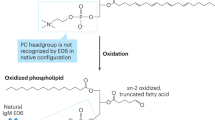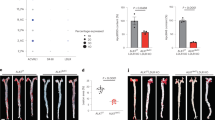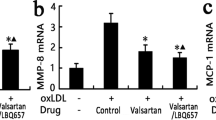Abstract
Increased lipoprotein-associated phospholipase A2 (Lp-PLA2) activity is associated with increased risk of cardiac events, but it is not known whether Lp-PLA2 is a causative agent. Here we show that selective inhibition of Lp-PLA2 with darapladib reduced development of advanced coronary atherosclerosis in diabetic and hypercholesterolemic swine. Darapladib markedly inhibited plasma and lesion Lp-PLA2 activity and reduced lesion lysophosphatidylcholine content. Analysis of coronary gene expression showed that darapladib exerted a general anti-inflammatory action, substantially reducing the expression of 24 genes associated with macrophage and T lymphocyte functioning. Darapladib treatment resulted in a considerable decrease in plaque area and, notably, a markedly reduced necrotic core area and reduced medial destruction, resulting in fewer lesions with an unstable phenotype. These data show that selective inhibition of Lp-PLA2 inhibits progression to advanced coronary atherosclerotic lesions and confirms a crucial role of vascular inflammation independent from hypercholesterolemia in the development of lesions implicated in the pathogenesis of myocardial infarction and stroke.
This is a preview of subscription content, access via your institution
Access options
Subscribe to this journal
Receive 12 print issues and online access
$209.00 per year
only $17.42 per issue
Buy this article
- Purchase on Springer Link
- Instant access to full article PDF
Prices may be subject to local taxes which are calculated during checkout





Similar content being viewed by others
Accession codes
References
Ross, R. Atherosclerosis—an inflammatory disease. N. Engl. J. Med. 340, 115–126 (1999).
Hansson, G.K. & Libby, P. The immune response in atherosclerosis: a double-edged sword. Nat. Rev. Immunol. 6, 508–519 (2006).
Steinberg, D. Thematic review series: the pathogenesis of atherosclerosis. An interpretive history of the cholesterol controversy, part V: the discovery of the statins and the end of the controversy. J. Lipid Res. 47, 1339–1351 (2006).
Witztum, J.L. The oxidation hypothesis of atherosclerosis. Lancet 344, 793–795 (1994).
Shah, P.K. Molecular mechanisms of plaque instability. Curr. Opin. Lipidol. 18, 492–499 (2007).
Kolodgie, F.D. et al. Intraplaque hemorrhage and progression of coronary atheroma. N. Engl. J. Med. 349, 2316–2325 (2003).
Virmani, R. et al. Lessons from sudden coronary death: a comprehensive morphological classification scheme for atherosclerotic lesions. Arterioscler. Thromb. Vasc. Biol. 20, 1262–1275 (2000).
Spagnoli, L.G. et al. Extracranial thrombotically active carotid plaque as a risk factor for ischemic stroke. J. Am. Med. Assoc. 292, 1845–1852 (2004).
McIntyre, T.M. et al. Biologically active oxidized phospholipids. J. Biol. Chem. 274, 25189–25192 (1999).
Prescott, S.M. et al. Platelet-activating factor and related lipid mediators. Annu. Rev. Biochem. 69, 419–445 (2000).
Macphee, C.H., Nelson, J.J. & Zalewski, A. Lipoprotein-associated phospholipase A2 as a target of therapy. Curr. Opin. Lipidol. 16, 442–446 (2005).
Zalewski, A. & Macphee, C. Role of lipoprotein-associated phospholipase A2 in atherosclerosis: biology, epidemiology, and possible therapeutic target. Arterioscler. Thromb. Vasc. Biol. 25, 923–931 (2005).
Tsimikas, S., Tsironis, L.D. & Tselepis, A.D. New insights into the role of lipoprotein(a)-associated lipoprotein-associated phospholipase A2 in atherosclerosis and cardiovascular disease. Arterioscler. Thromb. Vasc. Biol. 27, 2094–2099 (2007).
Garza, C.A. et al. Association between lipoprotein-associated phospholipase A2 and cardiovascular disease: a systematic review. Mayo Clin. Proc. 82, 159–165 (2007).
Macphee, C.H. et al. Lipoprotein-associated phospholipase A2, platelet-activating factor acetylhydrolase, generates two bioactive products during the oxidation of low-density lipoprotein: use of a novel inhibitor. Biochem. J. 338, 479–487 (1999).
Davis, B. et al. Electrospray ionization mass spectrometry identifies substrates and products of lipoprotein-associated phospholipase A2 in oxidized human low density lipoprotein. J. Biol. Chem. 283, 6428–6437 (2008).
Kougias, P. et al. Lysophosphatidylcholine and secretory phospholipase A2 in vascular disease: mediators of endothelial dysfunction and atherosclerosis. Med. Sci. Monit. 12, RA5–RA16 (2006).
Shi, Y. et al. Role of lipoprotein-associated phospholipase A2 in leukocyte activation and inflammatory responses. Atherosclerosis 191, 54–62 (2007).
Carpenter, K.L. et al. Mildly oxidised LDL induces more macrophage death than moderately oxidised LDL: roles of peroxidation, lipoprotein-associated phospholipase A2 and PPARγ. FEBS Lett. 553, 145–150 (2003).
Perez, R. et al. Involvement of group VIA calcium-independent phospholipase A2 in macrophage engulfment of hydrogen peroxide–treated U937 cells. J. Immunol. 176, 2555–2561 (2006).
Aprahamian, T. et al. Impaired clearance of apoptotic cells promotes synergy between atherogenesis and autoimmune disease. J. Exp. Med. 199, 1121–1131 (2004).
Kolodgie, F.D. et al. Lipoprotein-associated phospholipase A2 protein expression in the natural progression of human coronary atherosclerosis. Arterioscler. Thromb. Vasc. Biol. 26, 2523–2529 (2006).
Blackie, J.A. et al. The identification of clinical candidate SB-480848: a potent inhibitor of lipoprotein-associated phospholipase A2 . Bioorg. Med. Chem. Lett. 13, 1067–1070 (2003).
Gerrity, R.G. et al. Diabetes-induced accelerated atherosclerosis in swine. Diabetes 50, 1654–1665 (2001).
Mohler, E.R., III et al. Site-specific atherogenic gene expression correlates with subsequent variable lesion development in coronary and peripheral vasculature. Arterioscler. Thromb. Vasc. Biol. 28, 850–855 (2008).
Chatzizisis, Y.S. et al. Role of endothelial shear stress in the natural history of coronary atherosclerosis and vascular remodeling: molecular, cellular and vascular behavior. J. Am. Coll. Cardiol. 49, 2379–2393 (2007).
Jo, H. et al. Role of NADPH oxidases in disturbed flow- and BMP4- induced inflammation and atherosclerosis. Antioxid. Redox Signal. 8, 1609–1619 (2006).
Schaloske, R.H. & Dennis, E.A. The phospholipase A2 superfamily and its group numbering system. Biochim. Biophys. Acta 1761, 1246–1259 (2006).
Gardner, A.A., Reichert, E.C., Topham, M.K. & Stafforini, D.M. Identification of a domain that mediates association of platelet-activating factor acetylhydrolase with high-density lipoprotein. J. Biol. Chem. 283, 17099–17106 (2008).
Stafforini, D.M. et al. Molecular basis of the interaction between plasma platelet-activating factor acetylhydrolase and low density lipoprotein. J. Biol. Chem. 274, 7018–7024 (1999).
Heller, E.A. et al. Chemokine CXCL10 promotes atherogenesis by modulating the local balance of effector and regulatory T cells. Circulation 113, 2301–2312 (2006).
Swirski, F.K. et al. Ly-6Chi monocytes dominate hypercholesterolemia-associated monocytosis and give rise to macrophages in atheromata. J. Clin. Invest. 117, 195–205 (2007).
Papaspyridonos, M. et al. Novel candidate genes in unstable areas of human atherosclerotic plaques. Arterioscler. Thromb. Vasc. Biol. 26, 1837–1844 (2006).
Reddy, V.y., Zhang, Z.-Y. & Weiss, S.J. Pericellular mobilization of the tissue-destructive cysteine proteinases, cathepsins B, L and S by human monocyte-derived macrophages. Proc. Natl. Acad. Sci. USA 92, 3849–3853 (1995).
Heart Protection Study Collaborative Group. MRC/BHF Heart Protection Study of cholesterol-lowering with simvastatin in 5693 people with diabetes: a randomized placebo-controlled trial. Lancet 361, 2005–2013 (2003).
Moreno, P.R. et al. Coronary composition and macrophage infiltration in atherectomy specimens from patients with diabetes mellitus. Circulation 102, 2180–2184 (2000).
Burke, A.P. et al. Morphologic findings of coronary atherosclerotic plaques in diabetics: a postmortem study. Arterioscler. Thromb. Vasc. Biol. 24, 1266–1271 (2004).
Pennathur, S. & Heinecke, J.W. Mechanisms for oxidative stress in diabetic cardiovascular disease. Antioxid. Redox Signal. 9, 955–969 (2007).
Tacke, F. et al. Monocyte subsets differentially employ CCR2, CCR5 and CX3CR1 to accumulate within atherosclerotic plaques. J. Clin. Invest. 117, 185–194 (2007).
Navab, M. et al. The oxidation hypothesis of atherogenesis: the role of oxidized phospholipids and HDL. J. Lipid Res. 45, 993–1007 (2004).
Sangvanich, P., Mackness, B., Gaskell, S.J., Durrington, P. & Mackness, M. The effect of high-density lipoproteins on the formation of lipid/protein conjugates during in vitro oxidation of low-density lipoprotein. Biochem. Biophys. Res. Commun. 300, 501–506 (2003).
Getz, G.S. & Reardon, C.A. Diet and murine atherosclerosis. Arterioscler. Thromb. Vasc. Biol. 26, 242–249 (2006).
Caslake, M.J. et al. Lipoprotein-associated phospholipase A2, platelet-activating factor acetylhydrolase: a potential new risk factor for coronary artery disease. Atherosclerosis 150, 413–419 (2000).
Van Eck, M. et al. Bone marrow transplantation in apolipoprotein E–deficient mice. Effect of ApoE gene dosage on serum lipid concentrations, βVLDL catabolism, and atherosclerosis. Arterioscler. Thromb. Vasc. Biol. 17, 3117–3126 (1997).
Singer, A.G. et al. Interfacial kinetic and binding properties of the complete set of human and mouse groups I, II, V, X and XII secreted phospholipases A2 . J. Biol. Chem. 277, 48535–48549 (2002).
Smart, B.P. et al. Inhibition of the complete set of mammalian secreted phospholipases A2 by indole analogues: a structure-guided study. Bioorg. Med. Chem. 12, 1737–1749 (2004).
Acknowledgements
The superb animal husbandry of H. Profka is gratefully acknowledged. We greatly appreciate the input by M. Hurle into the design and confirmation of the Taqman probes and the advice and support related to immunofluorescence procedures of P. Crino. These studies were supported by funding from GlaxoSmithKline through an industry-academic alliance via the Alternative Drug Discovery Initiative with the University of Pennsylvania School of Medicine. M.H.G. is funded by US National Institutes of Health grant R37HL036235.
Author information
Authors and Affiliations
Contributions
R.L.W., Y.S., E.R.M., III, M.C.W., A.Z. and C.H.M. conceived and designed the project and analyzed all data. R.L.W. and C.H.M. wrote the manuscript. Y.S., L.Z. and P.Z. performed studies on vascular inflammation. D.H., R.S.F., D.J.P., J.Y. and R.C.M. performed the histological and immunohistochemical analyses. M.E.B. performed statistical analysis. J.L. and B.E.H. performed the real-time PCR. A.P. performed the mass spectrometry. J.G.B. and M.H.G. determined selectivity of darapladib. C.L.W. carried out the analysis of Lp-PLA2 activity.
Corresponding author
Ethics declarations
Competing interests
R.L.W., Y.S., E.R.M., III and A.P. are recipients of research grants from GlaxoSmithKline. M.E.B., B.E.H., R.C.M.,C.L.W., M.C.W., A.Z. and C.H.M. are employees of GlaxoSmithKline, the manufacturer of darapladib.
Supplementary information
Supplementary Text and Figures
Supplementary Tables 1–3 and Supplementary Methods (PDF 256 kb)
Rights and permissions
About this article
Cite this article
Wilensky, R., Shi, Y., Mohler, E. et al. Inhibition of lipoprotein-associated phospholipase A2 reduces complex coronary atherosclerotic plaque development. Nat Med 14, 1059–1066 (2008). https://doi.org/10.1038/nm.1870
Received:
Accepted:
Published:
Issue Date:
DOI: https://doi.org/10.1038/nm.1870
This article is cited by
-
Diabetes status modifies the long-term effect of lipoprotein-associated phospholipase A2 on major coronary events
Diabetologia (2022)
-
Lp-PLA2 inhibition prevents Ang II-induced cardiac inflammation and fibrosis by blocking macrophage NLRP3 inflammasome activation
Acta Pharmacologica Sinica (2021)
-
Elevated dietary ω-6 polyunsaturated fatty acids induce reversible peripheral nerve dysfunction that exacerbates comorbid pain conditions
Nature Metabolism (2021)
-
Active site competition is the mechanism for the inhibition of lipoprotein-associated phospholipase A2 by detergent micelles or lipoproteins and for the efficacy reduction of darapladib
Scientific Reports (2020)
-
Lipoprotein-associated phospholipase A2 predicts cardiovascular events in dialyzed patients
Journal of Nephrology (2019)



